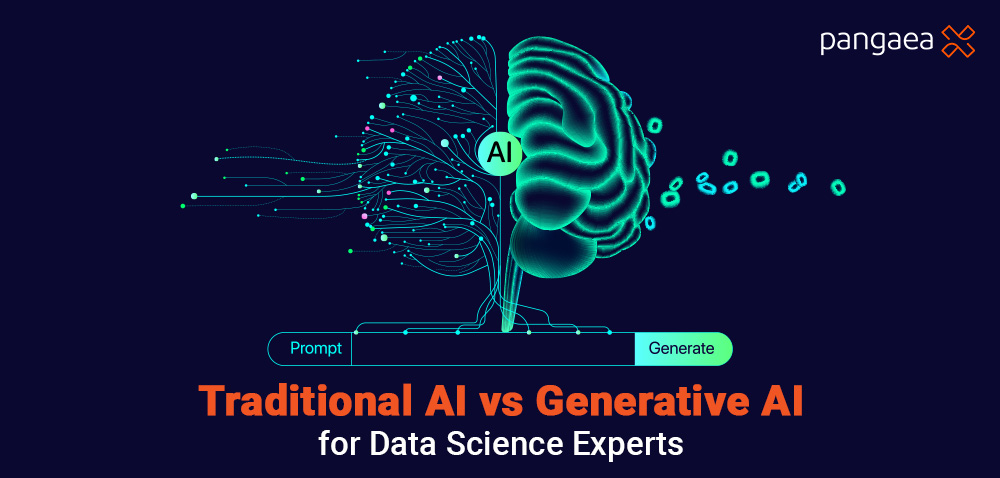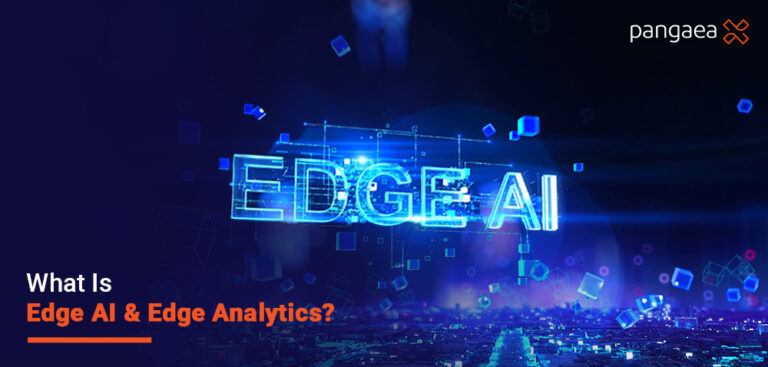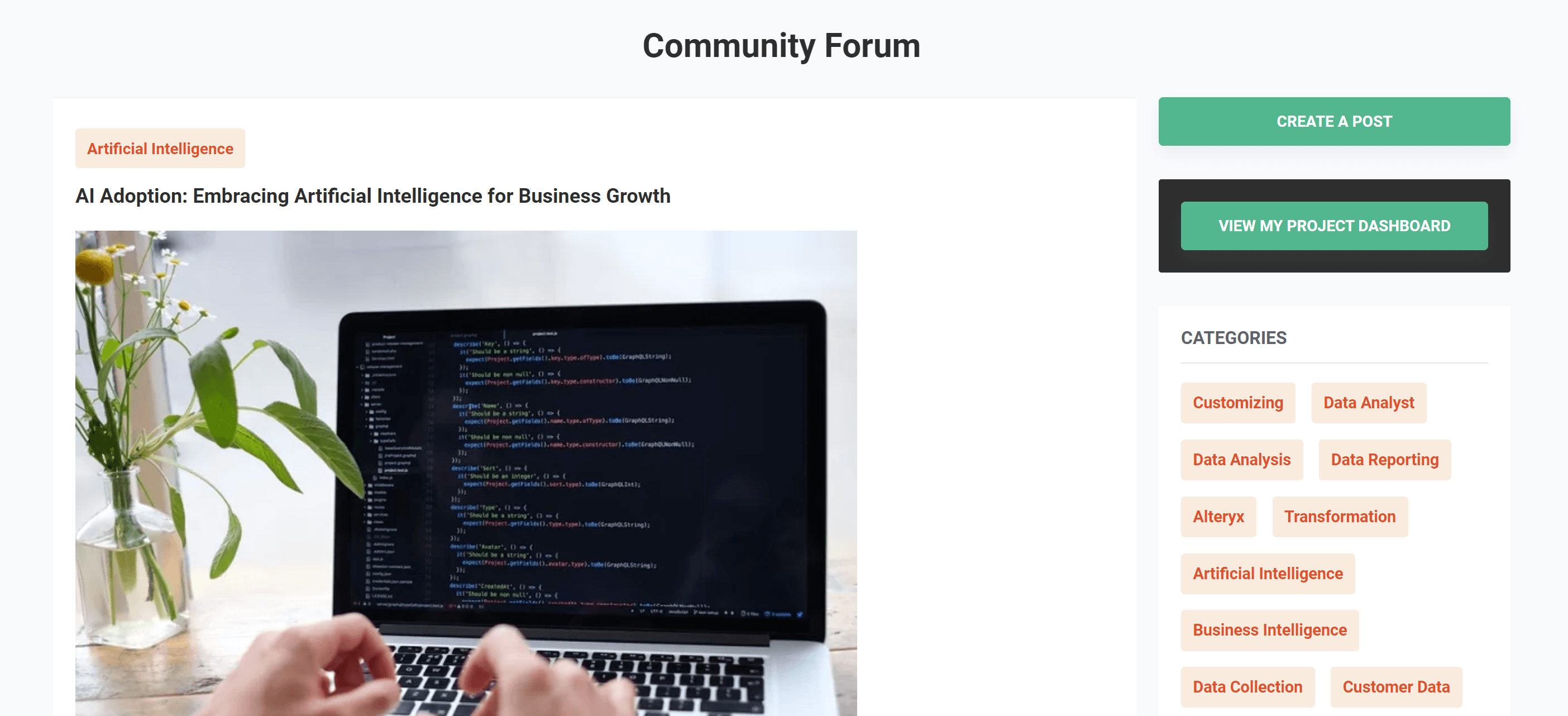Traditional AI vs. Generative AI: What Data Scientists Need to Know in 2025

Introduction to AI: Traditional vs. Generative
Artificial Intelligence is no longer a monolithic domain; it’s evolving into distinct branches with unique capabilities. Among these, Generative AI and Traditional AI are shaping the future of data-driven industries in drastically different ways.
As 2025 unfolds, businesses are leveraging AI not only for automation and prediction but also for innovation, personalization, and content creation. The rise of large language models (LLMs), no-code tools, and AI copilots is pushing the boundaries of what’s possible, from real-time analytics to dynamic content generation.
For data scientists, understanding these two AI paradigms is essential, not just to stay relevant, but to build smarter solutions, offer more value, and position themselves competitively in a rapidly evolving tech landscape. This blog unpacks the differences between Generative and Traditional AI, discusses tools, applications , ethical implications, and offers a roadmap for data Scientists and freelancers looking to capitalize on both.
What is Traditional AI?
Traditional AI, often referred to as rule-based or task-specific AI, focuses on learning from existing data to predict outcomes or automate decisions. These systems typically operate under structured, supervised learning models using historical data to generate patterns.
Some prominent examples of Traditional AI include:
- Fraud detection algorithms in banking
- Predictive maintenance in manufacturing
- Recommendation systems for e-commerce
- Customer segmentation in marketing
The hallmark of Traditional AI is its reliability and explainability. These models are interpretable, easy to audit, and often more cost-effective for clearly defined use cases.
What Is Generative AI?
Generative AI, on the other hand, is designed not just to analyze data but to create new data outputs. Powered by neural networks—especially transformers—Generative AI can produce coherent text, generate images, write code, and simulate realistic voices.
This class of AI uses unsupervised or semi-supervised learning to generate outputs that mimic human creativity. Key tools and platforms include:
- ChatGPT for natural language generation
- DALL·E and Midjourney for image generation
- GitHub Copilot for coding assistance
- Runway and Synthesia for video content creation
As explored in Generative AI and Data Science: Top Tools & Trends for 2025, this new wave of tools is transforming how data science is practiced—enabling analysts to move from insight generation to content creation.
Difference between Generative AI and Traditional AI
| Feature/Criteria | Traditional AI | Generative AI |
| Core Function | Predict outcomes | Create content or data |
| Input Data | Structured datasets | Structured + unstructured inputs |
| Output | Scores, labels, classifications | Text, visuals, audio, synthetic data |
| Common Techniques | Logistic Regression, XGBoost | LLMs, Diffusion Models, GANs |
| Interpretability | High | Lower |
| Example Use Case | Fraud detection | AI-generated content |
| Industries Dominated | Finance, Healthcare, Supply Chain | Marketing, Education, Media, Product Development |
Understanding when to use each paradigm is crucial for building efficient and responsible AI-driven solutions.
Applications of Traditional AI in Data Science
Traditional AI remains the backbone of many enterprise AI applications. It continues to drive value in operational optimization, risk management, and business intelligence.
1. Predictive Analytics
Forecast future trends using historical data—for instance, sales forecasting, customer churn prediction, or demand estimation in supply chains.
2. Anomaly Detection
Used heavily in sectors like cybersecurity and finance to identify abnormal behavior such as fraudulent transactions or network intrusions in real time.
3. Classification & Clustering
Identify user segments or categorize documents and emails using supervised (SVM, random forests) or unsupervised methods (K-means, DBSCAN).
4. Recommendation Engines
Analyze customer behavior and suggest personalized products or content—widely used in e-commerce and streaming platforms.
5. Natural Language Processing (NLP)
Traditional NLP tasks like sentiment analysis, named entity recognition, and text classification still rely heavily on traditional AI and shallow learning models.
Applications of Generative AI in Data Science
Generative AI is revolutionizing how data scientists interact with tools, automate workflows, and even generate new datasets.
1. Text and Report Generation
Generate automated reports, summaries, or insights from raw data using tools like GPT-4. This saves time in client-facing projects where interpretability matters.
2. Code Generation and Assistance
Freelancers and engineers use tools like GitHub Copilot to autocomplete code, generate boilerplate, and explain unfamiliar code blocks—accelerating development.
3. Synthetic Data Creation
Create high-quality synthetic datasets that mimic real-world distributions, which is crucial for training models in privacy-sensitive industries like healthcare and finance.
4. Data Augmentation
Enhance training datasets with generated samples (images, text, etc.) to improve model robustness and accuracy.
5. Conversational AI & Chatbots
Generative LLMs power natural, dynamic chatbots that serve in customer service, HR onboarding, and internal knowledge management.
How Do Freelancers Benefit from Generative and Traditional AI in 2025?
The freelance market is booming in the AI space. With global talent pools and remote collaboration now the norm, freelance data scientist experts are highly sought after.
Benefits for Freelancers:
- Broader Project Scope: Combine predictive modeling (Traditional AI) with content or report generation (Generative AI) for a holistic offering.
- Rapid Prototyping: Use pre-trained APIs and drag-and-drop tools to deliver MVPs in record time.
- Infrastructure-Free Tools: Many Gen AI tools run in the cloud, removing the need for costly hardware.
- Higher Billable Rates: Niche roles like prompt engineers or synthetic data creators are commanding premium fees.
For businesses looking to hire freelance data scientist experts, the combination of Traditional and Generative AI capabilities unlocks faster, cost-effective project delivery. Freelancers can now deliver end-to-end AI workflows—from ingesting raw data to presenting insights in dynamic, AI-generated dashboards.
What Ethical Issues Should Data Scientists Watch for in 2025?
As AI becomes more powerful, it also becomes more prone to misuse and bias. Ethics should be part of every data scientist’s workflow.
Traditional AI Concerns:
- Model Bias: Bad training data leads to unfair outcomes, especially in finance or hiring.
- Explainability: Without clear explanations, models can’t be trusted in regulated industries.
Generative AI Risks:
- Hallucination of Facts: LLMs may fabricate statistics or content that seems plausible but is inaccurate.
- Misinformation & Deepfakes: Generative AI can spread fake news, damage reputations, or violate IP laws.
- Plagiarism & IP Conflicts: Using AI-generated content without proper oversight can lead to legal issues.
Solutions:
- Perform bias audits regularly.
- Use explainable AI (XAI) tools.
- Apply ethical frameworks like Model Cards and Datasheets for Datasets.
Ethical data science isn’t optional,it’s a differentiator for freelance data scientist experts and enterprise teams.
Data Science Trends to Watch in 2025
2025 is a tipping point year. AI is not only transforming existing processes but creating new markets and user experiences. Here are the trends every data scientist should keep on their radar:
1. AI Copilots Become Standard
From Excel to VS Code, tools like Copilot are being embedded into everyday workflows. Freelancers can now automate documentation, code comments, testing, and even storytelling.
2. Shift from Code to Prompts
Prompt engineering is emerging as a new programming language, allowing data scientists to communicate with models using natural language.
3. Growth of Open-Source LLMs
Tools like Mistral, Mixtral, and Llama 3 are gaining popularity, allowing businesses to self-host and fine-tune models for privacy and cost benefits.
4. Real-Time AI Analytics
Analytics dashboards are transforming into conversational interfaces, where business users can chat with their data using natural queries.
5. No-Code AI Tools
Platforms like Make.com, Zapier AI, and Akkio are democratizing data science. This creates pressure on professionals to deliver more complex, high-value solutions that can’t be built using templates.For a deeper dive into this, Read this article Top No-Code AI Tools for Data Analytics in 2025
Preparing for a Hybrid AI Future
Success in 2025 and beyond won’t come from specializing in only one area of AI. Instead, the most in-demand data scientists will be those who can fluently switch between Traditional and Generative AI, applying the right tools for the right problems.
Skills Roadmap for 2025:
- Model Deployment: Use Docker, FastAPI, and Gradio.
- LLM Integration: Build workflows with LangChain or Haystack.
- Vector Databases: Master Pinecone, Weaviate, or Chroma for semantic search.
- Interactive Dashboards: Use Streamlit with LLMs for client-facing tools.
- Ethical AI Consulting: Offer documentation and audits as part of your service package.
Freelancers who invest in both hard skills (modeling, coding) and soft skills (prompting, consulting) will dominate the market. The real winners will be those who know when to use a regression model and when to let an LLM write a summary for a client’s executive dashboard.
Final Thoughts
As 2025 unfolds, AI professionals must look beyond the hype and focus on practical value creation. While Traditional AI remains indispensable for forecasting and diagnostics, Generative AI is redefining what’s possible in automation, personalization, and content production.
Whether you’re an enterprise team lead or exploring new horizons as a freelance data scientist expert, mastering both paradigms opens the door to diverse, high-value opportunities. Platforms like Pangaea X are empowering businesses to easily hire freelance data scientist experts worldwide, making it simpler than ever to build hybrid AI solutions without the constraints of traditional hiring models.
Get your data results fast and accelerate your business performance with the insights you need today.



